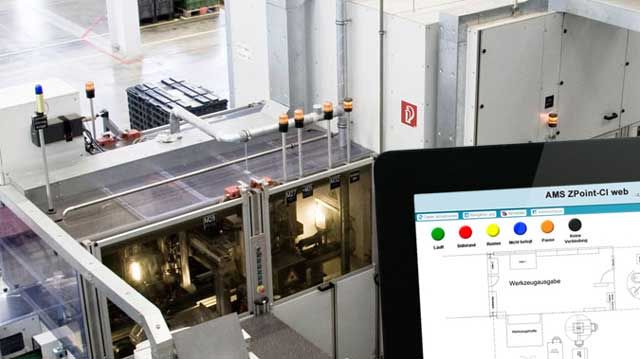STIWA Increases Total Production Output of Automation Machinery
"Our shopfloor management system AMS ZPoint-CI collects a huge amount of machine, process, and product data 24 hours a day. By analyzing this data immediately in MATLAB and AMS Analysis-CI we have achieved a tenfold increase in precision, a 30% reduction in total cycle time, and a significant increase in production output."
Challenge
Solution
Results
- Total cycle time reduced by 30%
- Large data sets analyzed in seconds
- Deployment to multiple machines streamlined

STIWA’s shopfloor management system, based on MATLAB, AMS ZPoint-CI, and AMS Analysis-CI. © STIWA Group.
Headquartered in Attnang-Puchheim, Austria, STIWA Automation GmbH is an industry leader in high-performance automation. The company’s 1200 employees at four locations provide STIWA customers with automated feeding, packaging, and transport systems as well as assembly and process modules.
STIWA engineers use MATLAB® to analyze large amounts of production data collected by the shopfloor management system AMS ZPoint-CI in near real time. This approach enables them to calculate time-optimal trajectories for machinery, reduce cycle times for production systems, and increase production output.
“MATLAB and STIWA manufacturing software enable us to employ algorithms to maximize the production capacity of mechanical systems, diagnose and correct system problems in software, and rapidly analyze the data we collect to optimize automation machinery,” says Alexander Meisinger, chief sales officer for manufacturing software at STIWA.
Challenge
Every eight seconds, a typical STIWA system collects more than 9 megabytes of raw production data in 150,000 data sets that capture noise, torque, and other machine measurements. This data must be filtered and processed to identify appropriate tolerances, compute time-optimized tracks for robots or flexible transfer systems, or modify the process—for example, by adjusting belt tension.
In the past, STIWA engineers wrote data analysis algorithms in low-level languages such as IEC 61131-3 Structured Text for PLCs. This approach was slow, and it became unworkable as the algorithms grew more complex. For example, the trajectory-planning algorithm calculates a path through four positions with joint constraints. Any change to the algorithm would require one day for PLC code implementation and a further day for error debugging.
STIWA needed to accelerate the development and execution of sophisticated algorithms for extracting useful information from large data sets. The company needed a development environment with built-in data analysis functions so that engineers could focus on problem solving, not low-level implementation details. They wanted to use tools that would be familiar to most new engineers. The tools had to make it easy to integrate algorithms with the company’s existing .NET production system. STIWA wanted to speed up algorithm execution by accessing the available multicore hardware infrastructure.
Solution
STIWA used MATLAB to implement a workflow for performing data analytics and optimizing total production output.
In this workflow, STIWA engineers import machine and product data into MATLAB and then filter, resample, and visualize the data to identify problems and optimization opportunities.
Working in MATLAB, the engineers develop algorithms to automate data analysis and plan time-optimal trajectories for robotic components. The algorithms invoke Optimization Toolbox™ functions to calculate these optimal trajectories based on defined constraints, including velocity and space limitations.
The team uses Parallel Computing Toolbox™ to speed the trajectory calculations by executing the optimization on workstations with up to six processing cores. They use the implicit parallelization of the fmincon function, and then vectorize the algorithm to enhance the performance of the implicit parallelization.
Before parallelizing the code, the engineers optimize their algorithms, using the MATLAB Profiler tool to identify the most time-consuming functions.
After unit testing, the team uses MATLAB Compiler™ and MATLAB Compiler SDK™ to package their completed algorithms as .NET components.
The .NET components undergo a final round of testing before they are deployed on a production system.
The integration of these components into the STIWA shopfloor management system based on AMS ZPoint-CI and AMS Analysis-CI enables closed control loops in production. The .NET components and the MATLAB algorithms they contain are invoked approximately every 10 seconds to analyze collected data and tune machine parameters.
Results
- Total cycle time reduced by 30%. “The time-optimal trajectory planning we performed using MATLAB, Optimization Toolbox, AMS ZPoint-CI, and AMS Analysis-CI enabled us to reduce the total cycle time for our machining processes by 30%, resulting in a significant increase in production output,” says Meisinger.
- Large data sets analyzed in seconds. “To be effective, our algorithms must analyze a huge amount of data in near real time,” says Martin Werner, software tools development engineer at STIWA. “We achieved this high level of performance by optimizing our MATLAB algorithms with the Profiler tool and by running trajectory optimizations on multiple cores with Parallel Computing Toolbox.”
- Deployment to multiple machines streamlined. “By using MATLAB Compiler SDK to integrate our MATLAB algorithms into a .NET production system, we can easily deploy the algorithm to several machines,” says Michael Pauditz, STIWA head of business unit manufacturing software.